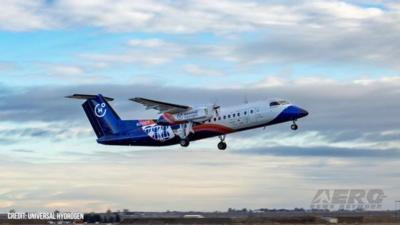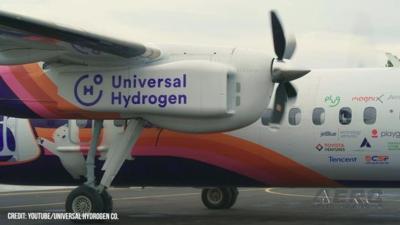U.H. Moves Flight Testing from MWH to MHV
Universal Hydrogen, the California energy concern about the business of making hydrogen-powered commercial flight a near-term reality, has selected California’s Mojave Air & Space Port as its new flight-test center.

The move occasioned the commencement of the next phase of Universal Hydrogen’s flight-testing campaign, the ultimate purpose of which is the vetting and certification of the company’s hydrogen-electric aero-powertrain.
Additionally, Universal Hydrogen announced the successful relocation to Mojave of Lightning McClean, a De Havilland Dash 8-300 regional airliner that functions as the company’s primary flight-testing platform.
Lightning McClean’s starboard-side, 2,380-shaft-horsepower Pratt & Whitney PW123 turboprop engine has been replaced by a hydrogen-electric powertrain comprising Universal Hydrogen’s hydrogen fuel-cells and MagniX’s Magni650 electric propulsion unit.
The eight-hundred-nautical-mile ferry flight began at east-central Washington state’s Grant County International Airport (MWH) and traveled down the U.S.’s west coast, making four stops before reaching Mojave.
The first three legs of the ferry mission saw Lightning McClean’s starboard-side hydrogen-electric powertrain utilized at takeoff, then powered down for the remainder of the flight. On the trip’s fourth and last leg, however, the hydrogen-electric powertrain was utilized continually, providing thrust throughout the sortie’s takeoff, cruise, approach, and landing segments. The one-hour, 180 nautical-mile flight was the longest to date by a hydrogen-electric powertrain.
Lightning McClean will reside, henceforth, at California’s Mojave Air & Space Port, supporting Universal Hydrogen’s flight-test operations in service of the company’s aspiration to see its hydrogen-electric powertrain FAA certified in late 2025.
Universal Hydrogen CTO Mark Cousin stated: "In our relentless pursuit to decarbonize aviation, moving our flight testing to Mojave brings us closer to our headquarters in Hawthorne, ensuring optimal coordination with the team. We extend our gratitude to Washington state and specifically Moses Lake for their invaluable support as we began our historic test flights with the largest hydrogen fuel cell-powered aircraft. Our calculated testing strategy guarantees the safety of our converted aircraft, propelling us towards our goal to have it in service within the next two years."
Mojave Air & Space Port general manager Tim Reid set forth: "Bringing Universal Hydrogen to the Mojave Air & Space Port is a big win for us and the local community. With their research and development, Universal Hydrogen’s technology will be a total game changer for zero-emission flight within the next decade, meeting the environmental goals of California while advancing the industry with a new, sustainable energy source. We are extremely excited to have Universal Hydrogen testing their concept at the Space Port.”

Initially, Universal Hydrogen intends to offer hydrogen-electric propulsion system conversions for the 78-passenger, French-built ATR-72 twin-engine turboprop regional airliner. Mr. Cousin stated: “Our current target is to have what’s called a supplemental type certificate, which is a certificate which allows the modification of an existing airplane. Our target is to have that ready and certified by the end of 2025.”
To date, Universal Hydrogen has struck ATR-72 conversion deals with numerous customers. The company’s aspirations are further-reaching, however. “We’ll make a business out of converting ATR-72s,” Mr. Cousin concluded. “It’s a good business. But the real aim is to demonstrate to the flying public, the airlines, and the customers of Airbus and Boeing that flying aircraft on hydrogen—particularly with this modular solution that we have for getting that hydrogen to the aircraft and loaded onto the aircraft—is a viable solution for that next generation of single-aisle aircraft.”
 ANN FAQ: Contributing To Aero-TV
ANN FAQ: Contributing To Aero-TV ANN's Daily Aero-Linx (05.29.24)
ANN's Daily Aero-Linx (05.29.24) ANN's Daily Aero-Term (05.29.24): NORDO (No Radio)
ANN's Daily Aero-Term (05.29.24): NORDO (No Radio) ANN's Daily Aero-Term (05.30.24): Beyond Visual Line Of Sight (BVLOS)
ANN's Daily Aero-Term (05.30.24): Beyond Visual Line Of Sight (BVLOS) ANN's Daily Aero-Linx (05.30.24)
ANN's Daily Aero-Linx (05.30.24)




